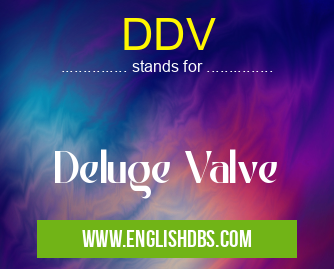What does DDV mean in UNCLASSIFIED
DDV stands for Deluge Valve. It is a type of valve used in fire protection systems to control the flow of water or other extinguishing agents.

DDV meaning in Unclassified in Miscellaneous
DDV mostly used in an acronym Unclassified in Category Miscellaneous that means Deluge Valve
Shorthand: DDV,
Full Form: Deluge Valve
For more information of "Deluge Valve", see the section below.
Definition
A Deluge Valve is a quick-opening valve designed to open automatically in response to a fire signal or manual activation. Once activated, it allows a large volume of water or extinguishing agent to flow into a protected area to suppress or extinguish a fire.
Features and Functionality
- Automatic Opening: Deluge valves are equipped with a triggering mechanism that opens the valve automatically when a fire is detected by heat or smoke detectors.
- Rapid Response: They are designed to open quickly, allowing the extinguishing agent to reach the fire area promptly.
- Large Flow Capacity: Deluge valves are capable of handling high flow rates, ensuring a sufficient supply of extinguishing agent to effectively suppress the fire.
- Manual Activation: In addition to automatic activation, deluge valves often have a manual override mechanism for emergency situations.
Applications
Deluge valves are commonly used in:
- Industrial Facilities: Warehouses, factories, and other areas with high fire risks.
- Commercial Buildings: Offices, shopping malls, and other densely populated areas.
- Data Centers: To protect critical infrastructure from fire damage.
- Airport Hangars: To quickly extinguish fires involving aircraft fuel.
Essential Questions and Answers on Deluge Valve in "MISCELLANEOUS»UNFILED"
What is a Deluge Valve (DDV)?
A Deluge Valve (DDV) is a valve designed to rapidly release a large volume of water or other extinguishing agent in the event of a fire or other emergency. It is typically used in sprinkler systems, where it is held closed by a fusible link or other triggering device until the temperature reaches a predetermined level.
How does a Deluge Valve work?
A Deluge Valve operates by holding back a volume of water or extinguishing agent until it receives a signal to open. This signal can come from a fire alarm system, a smoke detector, or a manual pull station. Once the signal is received, the valve opens rapidly, allowing the water or extinguishing agent to flow into the protected area.
Where are Deluge Valves used?
Deluge Valves are typically used in high-hazard areas where rapid fire suppression is essential, such as:
- Data centers
- Electrical rooms
- Warehouses
- Industrial plants
- Aircraft hangars
What are the different types of Deluge Valves?
There are several types of Deluge Valves, including:
- Open Deluge Valves: These valves remain open at all times, allowing water to flow into the protected area continuously.
- Closed Deluge Valves: These valves are normally closed and only open when a fire or other emergency signal is received.
- Pre-Action Deluge Valves: These valves are closed until a fire detection system confirms the presence of a fire, at which point they open and release water.
What are the benefits of using Deluge Valves?
Deluge Valves offer several benefits, including:
- Rapid fire suppression: Deluge Valves can release a large volume of water or extinguishing agent quickly, helping to suppress fires before they spread.
- Water conservation: Pre-Action Deluge Valves only release water when a fire is detected, conserving water and reducing the risk of water damage.
- Improved safety: Deluge Valves can help to protect people and property from the dangers of fire.
Final Words: Deluge valves play a vital role in fire protection systems by providing a rapid and effective means of extinguishing fires. Their automatic operation and large flow capacity make them suitable for protecting a wide range of high-risk facilities and assets.
